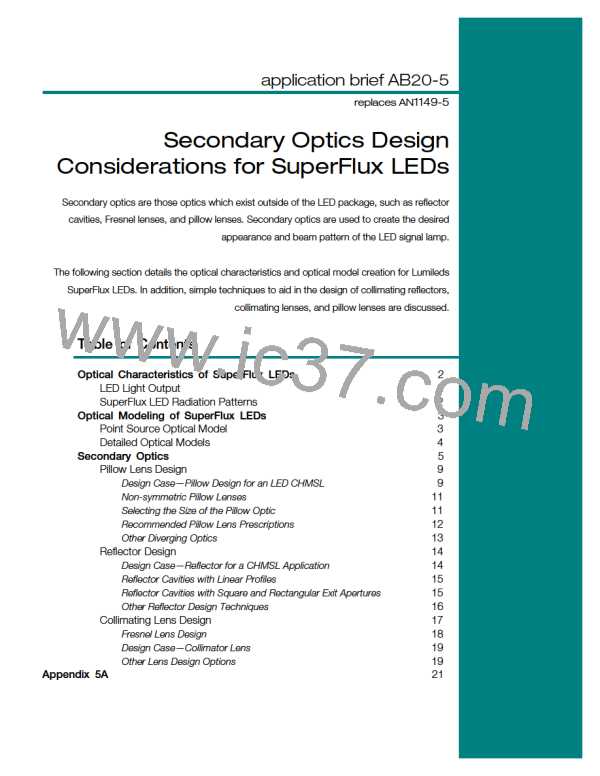at Figure 5.1, the 2q1/2 of the HPWA-Mx00 LED
is approximately 90°.
Looking at Figure 5.2, the total included angle is
approximately 95°. This implies that 90% of the
flux produced by an HPWA-Mx00 LED is emitted
within a 95° cone centered on the optical axis.
Another attribute that is of common interest is
the total included angle, or qv 0.9. This attribute
describes the cone angle within which 90% of
the total flux is radiated. Using Figure 5.1, the
percent of total flux versus included angle can
be calculated and graphed. (The derivation of
this graph is shown in Appendix 5A.) This graph
is included in the data sheet of SuperFlux LEDs
and is shown in Figure 5.2 for the HPWA-Mx00
LED.
Figure 5.1 Graph of the radiation pattern for an
HPWA-MxOO LED.
Optical Modeling of SuperFlux LEDs
An optical model of the LED is useful when
designing secondary optic elements such as
reflector cavities and pillow lenses. The optical
output of an LED can be approximated as a
point source of light passing through an
aperture, but modeling errors may be
unacceptable when lenses or reflectors are
placed within 25 mm of the SuperFlux LED. A
more accurate technique involves using an
optical model, which takes into account the
extended source size of the LED.
Point Source Optical Model
The internal structure of a SuperFlux LED is
shown in Figure 5.3. Light is produced in the
LED chip. A portion of this light goes directly
from the chip and is refracted by the epoxy
dome (refracted-only light). The remainder of
the light is reflected by the reflector cup and
then refracted by the epoxy dome (reflected-
refracted light).
Figure 5.2 Percent total flux vs. included angle for
an HPWA-MxOO LED.
The light that is refracted appears to come from
a certain location within the LED, while the light
which is reflected and refracted appears to
come from a different location. In addition,
because the LED chip itself has physical size
and is not a point source, the refracted-only light
does not appear to come from a single location,
but a range of locations or a focal smear. This is
true for the reflected-refracted light as well.
3

 LUMILEDS [ LUMILEDS LIGHTING COMPANY ]
LUMILEDS [ LUMILEDS LIGHTING COMPANY ]